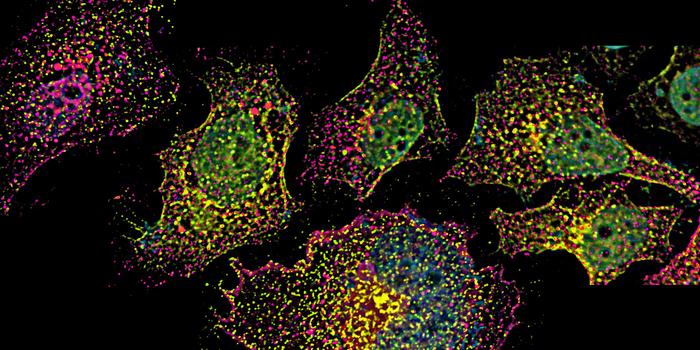A groundbreaking study spearheaded by researchers at the University of Basel offers a transformative insight into the intracellular dynamics that govern the efficacy of RNA-based drugs, particularly antisense oligonucleotides (ASOs). Published in the prestigious journal Nature Communications, this work delves into the cellular transport mechanisms that substantially limit the therapeutic outcomes of ASOs and unveils innovative strategies to overcome these barriers. The findings have profound implications for the treatment of rare genetic disorders, promising to enhance the potency of these molecular medicines without necessitating higher doses.
Personalized medicine has rapidly evolved into a central pillar for treating genetically rooted diseases. Among its most promising tools are ASOs, synthetic strands of nucleotides designed to selectively bind target RNA molecules inside cells. By blocking the production of abnormal or disease-causing proteins at the RNA level, ASOs present a highly specific therapeutic modality. Diseases that were once considered untreatable, such as amyotrophic lateral sclerosis (ALS) and Duchenne muscular dystrophy, have started to see meaningful clinical interventions through these RNA-based compounds.
Despite their transformative potential, one of the major hurdles in realizing the full efficacy of antisense therapies lies in their intracellular delivery and trafficking. After administration, ASOs are internalized by cells and end up sequestered in endosomes—membrane-bound compartments responsible for sorting and trafficking cellular material. If ASOs remain trapped in these vesicles, they are rapidly directed toward lysosomal degradation pathways, effectively neutralizing their therapeutic capacity. This sequestration represents a bottleneck that limits how much active drug reaches the cytoplasm where their RNA targets reside.
.adsslot_BlEZs8zohd{ width:728px !important; height:90px !important; }
@media (max-width:1199px) { .adsslot_BlEZs8zohd{ width:468px !important; height:60px !important; } }
@media (max-width:767px) { .adsslot_BlEZs8zohd{ width:320px !important; height:50px !important; } }
ADVERTISEMENT
The intricate kinetics of ASO trafficking through the endosomal-lysosomal system have remained elusive until now. By employing a comprehensive genome-wide CRISPR/Cas9 knockout screening, the international research consortium identified numerous genes that modulate the intracellular journey of ASOs. Among the most critical discoveries was the role of AP1M1, a gene encoding a component of the adaptor protein complex responsible for directing cargo from endosomes to lysosomes. This link illuminated a pivotal step that, when modulated, could enhance the retention of ASOs within endosomes.
Extended residence time within endosomes was found to considerably increase the likelihood of ASOs escaping into the cytosol before degradation. This phenomenon directly correlates to enhanced pharmacological activity of the drug as more molecules reach their intended RNA targets. Experimental downregulation of AP1M1 in both cultured human cells and mouse models demonstrated a notable increase in therapeutic efficiency without changing the administered dose. Such findings underscore that intracellular trafficking speeds are a key determinant of ASO success.
The mechanistic insights provided by this study extend beyond just antisense drugs. By revealing that controlled modulation of endosomal transit can amplify drug efficacy, the research sets a precedent for refining the intracellular delivery of diverse therapeutic agents. This may catalyze the innovation of sophisticated drug designs that not only consider target specificity but also intracellular dynamics to optimize therapeutic windows.
Moreover, the implications extend into infectious disease biology. Since many bacterial and viral pathogens exploit endosomal trafficking to escape degradation and infect cells, manipulating residence time inside endosomes could inhibit pathogen survival and replication. This concept opens intriguing new possibilities for therapeutic interventions that harness cellular transport pathways as indirect antimicrobial strategies.
The application of CRISPR/Cas9 technology was instrumental in this discovery, enabling systematic gene knockout to parse out genetic modulators of ASO intracellular transport. Through this advanced genetic screening platform, the team could comprehensively map the cellular machinery influencing RNA drug activity. This methodological approach demonstrates the power of combining cutting-edge genome editing with therapeutic research to unravel complex biological barriers.
ASOs, being small, synthetic nucleic acid fragments, rely heavily on cellular uptake mechanisms and intracellular sorting. Once internalized, their fate is largely determined by endosome-limiting escapes, a step bottlenecked by the rapid progression toward lysosomal degradation. By delaying this progression, the potential pool of bioactive ASOs substantially increases, leading to improved gene silencing effects.
In summary, the research from the University of Basel and Roche collaborators fundamentally redefines the parameters that influence RNA-based drug efficacy. Modulating the residence time of antisense oligonucleotides within endosomes emerges as a pivotal factor in their therapeutic success. The dual benefits of enhanced drug action and novel antimicrobial potential signify a breakthrough that could reshape clinical approaches to genetic diseases and infectious agents alike.
This pioneering work is poised to inspire a new wave of research focused on the dynamic interplay between drug molecules and intracellular transport mechanisms. As the field of personalized medicine marches forward, such insights will be critical in translating molecular therapies from bench to bedside with greater precision and effectiveness. Ultimately, this study not only sheds light on a crucial biological process but also charts a path for next-generation RNA therapeutics with broad-reaching clinical implications.
Subject of Research:
Intracellular transport mechanisms regulating the efficacy of RNA-based antisense oligonucleotide drugs.
Article Title:
Prolonged endosomal residence enhances antisense oligonucleotide efficacy by modulating intracellular trafficking.
News Publication Date:
Not specified in the source.
Web References:
https://doi.org/10.1038/s41467-025-61039-y
References:
Published article in Nature Communications, including genome-wide CRISPR/Cas9 functional screening and mechanistic studies on ASO intracellular transport.
Image Credits:
Biozentrum, University of Basel
Keywords:
Antisense RNA, Personalized medicine, Cell biology, Endosomes, RNA-based therapeutics
Tags: amyotrophic lateral sclerosis therapyantisense oligonucleotidesDuchenne muscular dystrophy treatmentgenetic disorders treatmentinnovative therapeutic strategiesintracellular delivery mechanismsmolecular medicine efficacyNature Communications publicationpersonalized medicine advancementsRNA therapiesRNA-based drug developmentUniversity of Basel research





